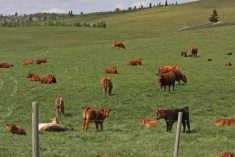Nut allergies
Pam, my daughter-in-law, is allergic to nuts. Whenever baking, I have
left nutmeg out of the recipe because of not knowing if it would be
classified as a nut. When asked, Pam said she also avoided using nutmeg
as she didn’t know either. For Pam and I and others who might also be
wondering, this is what I found out.
The Calgary Allergy Network has an article by Antony Ham Pong that says
food such as water chestnut, pine nuts (pignolia or pinyon nuts),
Read Also

Know what costs are involved in keeping crops in the bin
When you’re looking at full bins and rising calf prices, the human reflex is to hold on and hope for more. That’s not a plan. It’s a bet. Storage has a price tag.
coconut and nutmeg do not need to be avoided by nut allergic people
unless they are also allergic to these foods.
Tropical oils such as palm oil do not need to be avoided either. Seeds
such as sesame, sunflower, poppy, mustard, safflower and canola are
also OK unless you are allergic to these foods as well. If you’re not
sure, get tested, was the advice.
Nutmeg
Nutmeg comes from the nutmeg tree, which is a large tropical evergreen.
Two spices, nutmeg and mace, are produced from the fruit of this tree.
The nutmeg seed is encased in a mottled yellow, edible fruit, the size
and shape of a small peach. The fruit splits in half to reveal a
net-like, bright red covering over the seed. This is the aril, which is
dried and sold as mace.
Under the aril is a dark, shiny nut-like pit, and inside that pit is
the oval shaped seed that is the nutmeg. It is sold whole or ground.
Nutmeg has a nutty, warm and slightly sweet flavour that is used in
pies, puddings, custards, cookies and spice cakes. It combines well
with many cheeses and is included in soufflés and cheese sauces. In
soups, it works with tomatoes, split pea, chicken or black beans.
It complements egg dishes and vegetables like cabbage, spinach,
broccoli, beans, onions and eggplant. It flavours Italian sausages,
Scottish haggis and Middle Eastern lamb dishes. Nutmeg is indispensable
to eggnog and numerous mulled wines and punches.
Recycling ideas
Readers who are, or have been Women’s Institute members, know that each
meeting there is a roll call when members are asked, for example, to
bring something or to discuss a certain topic.
At the most recent Hughton Women’s Institute meeting, our roll call was
to bring an item that would have been thrown out but you made it into
something useful. A wide variety of items showed up at the meeting.
- The heaviest was a rock painted with a birthday message on it and
given to another member.
- The back of crossword puzzles cut up and used for grocery lists.
- A denim quilt made from old jeans.
- Tea lights inserted into the top of cut-up old fence posts, three
tied together (each at a different height) with pretty ribbon and made
into a decorative candle arrangement.
- The most humorous was a member wearing her mother-in-law’s slacks
with the mother-in-law not knowing they had been rescued from the
give-away bin. The mother-in-law was also at the meeting.
- A teddy bear made from an old fur coat.
- Square margarine containers used for cookie containers.
- A framed picture of a maple leaf, made from costume jewelry.
- I took liquid soap that I made from the bits of leftover bar soap. I
had been putting these bits in a container for some time thinking I
should be able to use them in some way. I did a bit of experimenting
and discovered the following recipe worked well for the kind of soap
bits I had.
In a microwaveable bowl, mix 350 grams (approximately one cup or 250
mL) of soap pieces with one cup (250 mL) of water. Heat on high in the
microwave for one minute. Stir.
Let sit for a few minutes and then heat and stir some more until the
soap pieces are dissolved. Cool and then pour into a soap dispenser.
Grating the soap pieces speeds the dissolving process. If too thick,
simply add a bit more water.
Eggs for healthy eating
The Canadian Egg Marketing Agency tells us that as of last January,
Canadian eggs teamed up with the Heart and Stroke Foundation’s Health
Check program.
Health Check is a national food information program developed by the
Heart and Stroke Foundation of Canada to respond to the needs of
consumers who want to make healthy food choices. All shell eggs qualify
for this symbol. The symbol will appear on many egg cartons in the
coming months.
At the heart of the Health Check program is the Health Check symbol,
backed by the Heart and Stroke Foundation name. This symbol on cartons
of Canadian eggs tells consumers that eggs make the grade for nutrient
criteria based on Canada’s Food Guide to Healthy Eating.
Research shows that no significant link has been established between
eating eggs and developing cardiovascular disease. Eggs are a good
source of essential nutrients and a healthy choice to take to heart.
Not only are they nutritious, they’re delicious, inexpensive and easy
to prepare.
For information on the many nutritional benefits of eggs, visit
www.canadaegg.ca.
Fat conversion chart
When baking, the following chart can be used to convert recipes from
solid fat to oil.
Solid fat Oil
1 cup (250 mL) = 131/2 tbsp. (202.5 mL)
3/4 cup (175 mL) = 10 tbsp. (150 mL)
1/2 cup (125 mL) = 7 tbsp. (105 mL)
1/4 cup (50 mL) = 31/2 tbsp. (45 mL)
Alma Copeland is a home economist from Rosetown, Sask., and one of four
columnists comprising Team Resources. Send correspondence in care of
this newspaper, Box 2500, Saskatoon, Sask., S7K 2C4.














